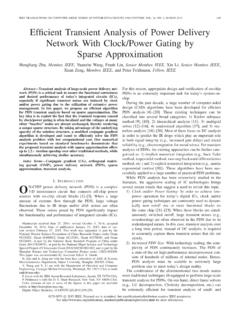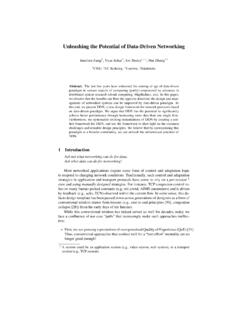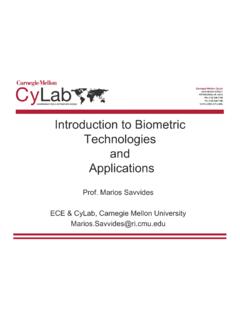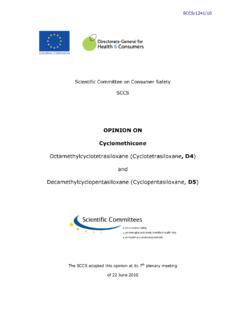Transcription of Cyclic Redundancy Code (CRC) Polynomial Selection For ...
1 Cyclic Redundancy code (CRC) Polynomial Selection For Embedded NetworksAbstractCyclic Redundancy Codes (CRCs) provide a first line ofdefense against data corruption in many , many commonly used CRC polynomialsprovide significantly less error detection capability thanthey might. An exhaustive exploration reveals that mostpreviously published CRC polynomials are either inferiorto alternatives or are only good choices for particularmessage lengths. Unfortunately these shortcomings andlimitations often seem to be paperdescribes a Polynomial Selection process for embeddednetwork applications and proposes a set of goodgeneral-purpose set of 35 newpolynomials in addition to 13 previously publishedpolynomials provides good performance for 3- to 16-bitCRCs for data word lengths up to 2048 IntroductionCyclic Redundancy Codes (CRCs) are commonly usedfor error detection in embedded networks and other appli-cations.
2 But many applications employ CRCs that providefar less error detection capability than they might achievefor a given number of CRC bits. This is largely becausethere is little published guidance and less quantitative dataupon which to base tradeoff decisions. To help improvethis situation, this paper proposes good general purposeCRCs for error detection applications that encompassmany current and future embedded network protocols andother uses having data words up to 2048 bits in various CRC designs can be found in standardsand folklore, most of them are far from optimal for theshort messages found in embedded networks. For embed-ded networks, the property of interest is usually theHamming Distance (HD), which is the minimum possiblenumber of bit inversions that must be injected into a mes-sage to create an error that is undetectable by that mes-sage's CRC-based Frame Check Sequence.
3 For example,if a CRC Polynomial has HD=6 for a given network, thatmeans there are no possible combinations of 1-, 2-, 3-, 4-,nor 5-bit errors (where a bit error is an inversion of a bitvalue) that can result in an undetected error, but there is atleast one combination of 6 bits that, when corrupted as a setwithin a message, is undetectable by that CRC. An addi-tional property of interest is burst error detection capabil-ity, but all codes we will discuss can detect burst errors upto the size of the CRC width. Other possible evaluationcriteria exist such as unidirectional bit error detection(which depends on data values) and high-noise there does not seem to be any authoritativecharacterization of faults in embedded networks. Our in-teractions with industry indicate that HD for random inde-pendent errors on a binary symmetric channel is usually theprimary factor considered in embedded network CRC de-sign, and thus is the metric we use in this a series of protocol evaluations for industry appli-cations in which the question arose as to whether it wouldbe possible to achieve a given Hamming Distance (HD)with a given CRC size, we decided to explore the designspace of CRC size, message length, and attainableHamming Distance.
4 The results indicate that there are sig-nificant opportunities for improving CRC effectivenessbecause some commonly used CRCs have poor perfor-mance. Moreover, many sources used in industrial prac-tice teach engineers to select a Polynomial without takinginto account the length of the data being error checked,which ignores an important engineering tradeoff. And,even if engineers want to make detailed design tradeoffs,tools and data tables on Polynomial performance are scarceand often difficult to paper presents a small set of polynomials that pro-vides good overall performance while including messagelength as a key design parameter. After discussing back-ground and previous work, a methodology for defining good CRC designs is proposed, and the results of apply-ing that methodology are presented. Comparisons of pub-lished CRCs to the proposed designs reveal both strengthsand serious weaknesses in the existing state of BackgroundA CRC can be thought of as a (non-secure) digest func-tion for a data word that can be used to detect data corrup-tion.
5 Mathematically, a CRC can be described as treating a1 Philip KoopmanECE Department & ICESC arnegie Mellon UniversityPittsburgh, PA, ChakravartyPittsburgh, PA, The International Conference on Dependable Systems and Networks, data word as a Polynomial over GF(2)( , with each Polynomial coefficient beingzero or one) and performing Polynomial di-vision by agenerator polynomialG(x),which is commonly called a CRC polyno-mial. (CRC polynomials are also known asfeedback polynomials , in reference to thefeedback taps of hardware-based shift regis-ter implementations.) The remainder of thatdivision operation provides an error detec-tion value that is sent as a Frame Check Se-quence (FCS) within a network message orstored as a data integrity check. Whether im-plemented in hardware or software, the CRCcomputation takes the form of a bitwise con-volution of a data word against a binary ver-sion of the CRC Polynomial .
6 The data wordsize is the data protected by the CRC but not including theCRC itself. [Peterson72] and [Lin83] are among the com-monly cited standard reference works for CRCs. [Wells99]provides a discussion for detection is performed by comparing an FCScomputed on data against an FCS value originally com-puted and either sent or stored with the original data. Anerror is declared to have occurred if the stored FCS andcomputed FCS values are not equal. However, as with alldigital signature schemes, there is a small, but finite, prob-ability that a data corruption that inverts a sufficient num-ber of bits in just the right pattern will occur and lead to anundetectable error. The minimum number of bit inversionsrequired to achieve such undetected errors ( , the HDvalue) is a central issue in the design of CRC the right Polynomial is central to CRC-based er-ror detection schemes.
7 The prime factorization of the gen-erator Polynomial brings with it certain potentialcharacteristics, and in particular gives a tradeoff betweenmaximum number of possible detected wordlength for which the Polynomial is effective. Many poly-nomials are good for short words but poor at long words,and the converse. Unfortunately, factorization of a polyno-mial is not sufficient to determine actual HDs. A polyno-mial with a promising factorization might be vulnerable tosome combination of bit errors, even for short messagelengths. Thus, factorization characteristics suggest poten-tial capabilities, but specific evaluation is required of anypolynomial before it is suitable for use in a CRC wisdom is that the best way to select aCRC Polynomial is to use one that is already commonlyused. For example, [Press92] lists 16-bit polynomials andstates the choice of Polynomial is only a matter of conven-tion.
8 This approach assumes that those polynomials wereselected for optimal error detection, which in some cases isincorrect. For example, several standardized 16-bit poly-nomials have error detection performance inferior to avail-able alternatives, and appear to have been chosen to mini-mize the number of 1 bits in the feedback value at a timewhen each such bit had substantial hardware implementa-tion cost. [Lin83] states that Polynomial Selection is avery difficult problem and says that some good cycliccodes have been discovered, but provides no details. Mostcoding theory and practice books are similar to [Wells99]in that they give only a handful of published polynomialsand little or no guidance on Polynomial Selection Hamming weightNis the number of errors, out of allpossible message corruptions, that is undetected by a CRCusing a particular Polynomial .
9 A set of Hamming weightscaptures performance for different numbers of bits cor-rupted in a message at a particular data word length, witheach successively longer data word length having set ofHamming weights with higher values. The first non-zeroHamming weight determines a code s Hamming 1 shows some example Hamming weights forCRC polynomials at a data word size of 48 bits, which is arepresentative length for many embedded networks. Thefirst Polynomial shown is the ubiquitous CCITT-16 poly-nomial 0x8810. 0x8810 is a hexadecimal representation ofthe Polynomial x16+x12+x5+1, with x16as the highest bitand an implicit +1 term, as is common in software-basedCRC implementations. It has only three feedback bitsset in the Polynomial , which was advantageous for earlyhardware implementations. For data words that are 48 bitsin length, CCITT-16 detects all 1-bit errors (as does anyCRC Polynomial ), and all 2- and 3-bit errors.
10 However, itonly provides HD=4 at this length because, as shown bythe weights in Table 1, it fails to detect 84 of all possible4-bit errors. In comparison, the 16-bit Polynomial 0xC86C[Baicheva00] attains HD=6 at this can also do better than CCITT-16 for this exampleusing smaller CRCs. The well known CAN 15-bit polyno-2 CRC Size(bits)CRC PolynomialHDHamming weights for number of bits corrupted:1 bit2 bits3 bits4 bits5 bits6 bits16 CCITT-160x881040008402 43016[Baicheva00] 0xC86C 6000002 19115 CAN0x62CC6000004 31412 CRC-120xC074000575028809120x8F8500001 45213 2588 DARC-80x9C206602 03913 122 124 2488 CRC-80xEA40002 9840253 0847 CRC-70x483002162 69027 051 226 85670x5B40005 5890451 125 Table 1. Example Hamming weights for data word size 48 0x62CC, which is optimized for data word sizes of upto 112 bits, provides HD=6 at this length, missing only4,314 of all possible 6-bit errors while using one less bit forits 15-bit CRC.













